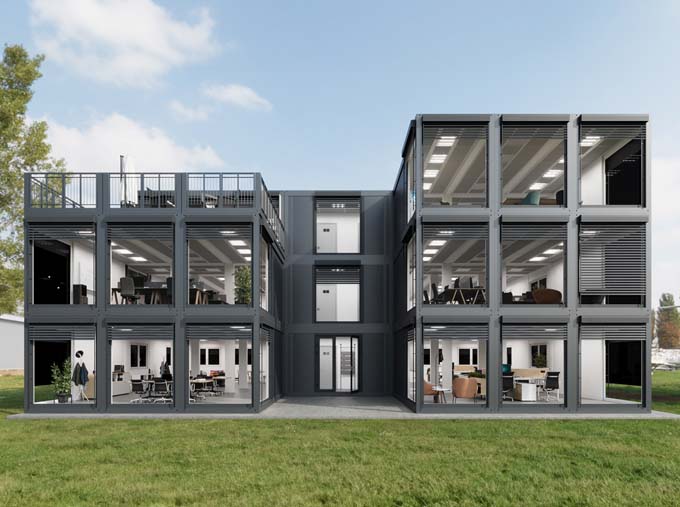CO2 can become a valuable resource
In a new study, researchers at the Paul Scherrer Institute (PSI) show that CO2 electrolysis can be profitable and contribute to climate protection. In this process, carbon dioxide is captured from the atmosphere or at the site of its generation, for example in industrial production. Subsequent conversion by electrolysis cell then makes this usable for the chemical industry.

One of the greatest challenges of our time is to reduce the concentration of carbon dioxide (CO2) and other greenhouse gases in the atmosphere. This is the only way we can halt climate change. To do this, it is not only necessary to rapidly reduce emissions from industry, transport and households. To achieve the agreed climate targets on time - as many analyses show - we also need to actively add CO2 or intercept it at the source to render it harmless.
An important question is: What happens to this greenhouse gas then? One possibility is to lock it away, so to speak. This is already being done in so-called CCS projects (Carbon Capture and Storage) and the CO2 pumped into underground storage facilities such as depleted natural gas or salt deposits. The other option is to use CO2 as a raw material - called CCU (Carbon Capture and Utilization). It can either serve directly as a fire extinguishing agent, refrigerant or fertilizer. More rewarding, however, is its use as a feedstock for other products.
Earlier studies by PSI and others have shown that the products carbon monoxide (CO) and formic acid (HCOOH) are particularly promising because they can be produced quite easily from carbon dioxide: together with water by electrolysis. Formic acid is used, for example, as an antirheumatic agent in medicine or as a mordant and impregnating agent in the textile and leather industries. Carbon monoxide, for example, is needed as a reducing agent in the smelting of ores - but above all it can be used together with hydrogen to produce synthetic fuels. And these are seen as very promising for the future, as they can replace diesel, gasoline, and kerosene from fossil sources and emit CO2-neutral.
PSI is doing a lot of research in this area: Together with Empa, the Materials and Technology Research Institute of the ETH Domain, the institute launched the SynFuels initiative at the beginning of this year, which is funded by the ETH Board. In addition, PSI was the lead partner in the federal government's Center of Competence for Research on Electricity and Heat Storage (SCCER Heat and Electricity Storage). Both initiatives made the research of the current study possible.
As part of the study, the PSI researchers, together with international colleagues, now investigated whether the electrolysis of CO2 to CO or HCOOH can be operated in an economically profitable way and whether it can produce more CO2 than it generates itself through its energy needs. In other words, can the process generate money and at the same time act as a CO2-Sink protect the climate?
Simulation of six different electrolysis factories
First, the researchers led by first author Bernhard Pribyl-Kranewitter - a doctoral student at PSI's Laboratory of Electrochemistry during the study - scoured the scientific literature for data on the most efficient low-temperature electrolyzer systems that produce CO and HCOOH. "We selected the four best designs for carbon monoxide production - including one patented in-house development by PSI - and the two best designs for formic acid production," Pribyl-Kranewitter explains. The researchers then virtually designed and modeled large-scale electrochemical plants for the production of the two chemicals for the respective cell architectures. "We used simulation software, some of which was very complex, to be able to represent the performance of the cells as realistically as possible on an industrial scale."
In their simulations, the researchers ran two scenarios: The first was based on current technology and assumed 75 tons of CO or HCOOH production per day. The second, optimistic scenario postulated that the technology would improve in the coming years and that progress would be made in some important parameters as well as in the possible total production. It simulated 100 tons per day. Both scenarios assumed a lifetime of 25 years for each of the plants.
The result of the simulations: Formic acid can be profitably produced in so-called microfluid cells in both scenarios. However, its production causes more CO2 than it consumes. This is mainly due to the comparatively high energy consumption: formic acid is produced as a liquid in solution with water and has to be separated in an energy-intensive process in order to be used. At the same time, less CO2 than for the same amount of carbon monoxide. The current EU electricity mix, more than half of which is still based on fossil fuels, produces 235 grams of CO2 per kilowatt hour. As CO2-Formic acid production could only serve as a sink at a value below 137 grams per kilowatt hour. In other words, the share of renewable energies must increase considerably before the electrolysis of CO2 to formic acid has a positive climate effect.
Carbon monoxide already has the potential to become a CO2-Sink
In the production of carbon monoxide in the alkaline cell systems commonly used for this purpose, a value of less than 346 grams per kilowatt hour is already sufficient because the product is produced as a gas and can be easily separated. "Carbon monoxide production therefore already has the potential to reduce CO2-sink," says project leader Thomas Justus Schmidt, head of the Energy and Environment research area at PSI. "And this becomes even greater as the share of renewable energy in the electricity mix increases." However, carbon monoxide could not be profitably produced with any cell architecture in the baseline scenario, where the electrolysis cell developed at PSI achieved the highest potential. In the optimistic scenario, on the other hand, all four architectures were able to achieve a positive result, and PSI's was even better than one of the cells used to produce formic acid. "Even though these results are already positive, the economic potential of our cell architecture has not yet been exhausted," Pribyl-Kranewitter says. In addition, the researchers hope that the costs for catalysts and membranes will decrease.
"The study result is very promising," Schmidt emphasizes. Carbon monoxide production showed an average improvement of 22 percent in the optimistic scenario compared to formic acid production. In other words, if the technology still evolves and prices improve as expected, carbon monoxide has the greatest bottom-line potential for economic and environmental use of carbon dioxide. "Its production can make an important contribution to the energy turnaround, as it is a so-called negative emissions technology," says Schmidt. Especially since the market here is much larger than for formic acid. Global CO production in 2015 was 210 gigatons, while that of HCOOH in 2019 was only 0.76 megatons, a mere fraction. "We should therefore focus on further developing the CO2-electrolysis for carbon monoxide production," Schmidt recommends. "And pursue formic acid as an alternative."









